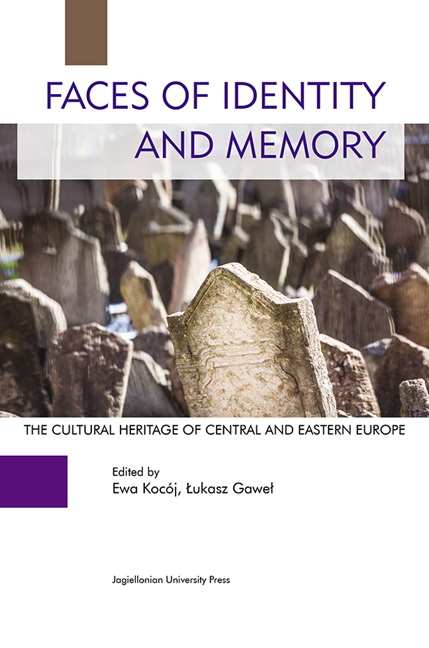 Faces of Identity and Memory
Faces of Identity and Memory Book contents
- Frontmatter
- Contents
- Introduction
- Memory and Identity. Monuments of Romanian Tangible Culture Inscribed on the UNESCO World Heritage List (a Short Presentation)
- Inventorisation and Recording of Sacral Art Objects in Lithuania in 1995–2005
- National lieux de mémoire and the European Heritage Label. Some Reflections on the Case of the Gdańsk Shipyard
- Porrajmos. Constructing Gypsy Holocaust Memory in the Recent Cinema
- The Vacuum and the Imagination of Space. The Cultural Role of the Żyznowski Publishing House
- Cultural Animation as the Art of Remembering. The Activities of the “Borderland of Arts, Cultures and Nations” Centre in Sejny
- ‘The Painted Village’ – Zalipie as an Expression of Ethnographic Tourism in the Powiśle Dąbrowskie Region of Poland
- 20th Century Theatrical Heritage: The Escape from Illusion
- Protection of Cultural Heritage. The Case of Krakow
- Managing an Artist's Legacy on the Example of Foundation for Support of Modjeska's Life and Art Research in Kraków
- Culinary Heritage as Used in the Present. Selected Elements of the Culinary Heritage Management in Contemporary Poland
Culinary Heritage as Used in the Present. Selected Elements of the Culinary Heritage Management in Contemporary Poland
Published online by Cambridge University Press: 10 January 2018
- Frontmatter
- Contents
- Introduction
- Memory and Identity. Monuments of Romanian Tangible Culture Inscribed on the UNESCO World Heritage List (a Short Presentation)
- Inventorisation and Recording of Sacral Art Objects in Lithuania in 1995–2005
- National lieux de mémoire and the European Heritage Label. Some Reflections on the Case of the Gdańsk Shipyard
- Porrajmos. Constructing Gypsy Holocaust Memory in the Recent Cinema
- The Vacuum and the Imagination of Space. The Cultural Role of the Żyznowski Publishing House
- Cultural Animation as the Art of Remembering. The Activities of the “Borderland of Arts, Cultures and Nations” Centre in Sejny
- ‘The Painted Village’ – Zalipie as an Expression of Ethnographic Tourism in the Powiśle Dąbrowskie Region of Poland
- 20th Century Theatrical Heritage: The Escape from Illusion
- Protection of Cultural Heritage. The Case of Krakow
- Managing an Artist's Legacy on the Example of Foundation for Support of Modjeska's Life and Art Research in Kraków
- Culinary Heritage as Used in the Present. Selected Elements of the Culinary Heritage Management in Contemporary Poland
Summary
Abstract: The issue addressed in the following text has been the subject of research for a long time now, but it has only relatively recently become an element of practical management, as local and regional cuisine is increasingly oft en used for marketing, tourism product development and for supporting regional and local entrepreneurship. The text is divided into two parts: in the first part, the author presents a brief history of Polish cuisine. The second part focuses on the contemporary usage of culinary heritage in many contexts, including regional policy.
Key words: culinary heritage, management, regional policy, food and wine studies, regional development
When perusing a restaurant menu for a dish that could be recommended to a foreigner as typically Polish, we may find a few staples such as kotlet schabowy (a pork breaded cutlet), żur or żurek (sour rye soup) or bigos (meat and sauerkraut stew). Then, a question comes to mind about which dish is the most characteristic of Polish cuisine, which is a tradition or part of the heritage, for how long certain traditions been around and how certain foods with long traditions have evolved over the years or centuries. This issue has been the subject of research for a long time now, but it has only relatively recently become an element of practical management, as local and regional cuisine is increasingly oft en used for marketing, tourism product development and for supporting regional and local entrepreneurship.
The aforementioned pork breaded cutlet has various marketing names and is served with different extras that are to make a particular cutlet stand out from the crowd of other chops prepared according to the same recipe. It may be served “under the blanket” of cheese or mushrooms, with gravy, or with garlic butter, the latter being particularly popular today. In principle, however, it is prepared in the same fashion across the country – it is a fried piece of pork coated with breadcrumbs. It, most probably, dates back to the 19th century and is certainly mentioned in one of the most well-known cookbooks of that period. The book's author, Lucyna Ćwierciakiewiczowa, allows for both breadcrumbing a piece of meat with the obligatory bone (today, the bone is typically removed) or frying it without such coating.
- Type
- Chapter
- Information
- Faces of Identity and MemoryThe Cultural Heritage of Central and Eastern Europe (Managing and Case Studies), pp. 199 - 223Publisher: Jagiellonian University PressPrint publication year: 2015


